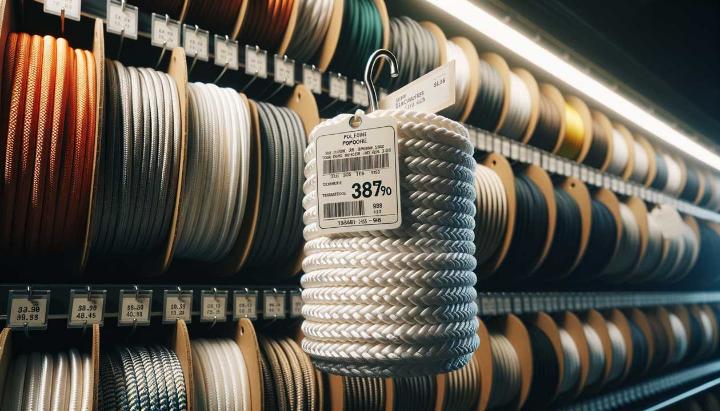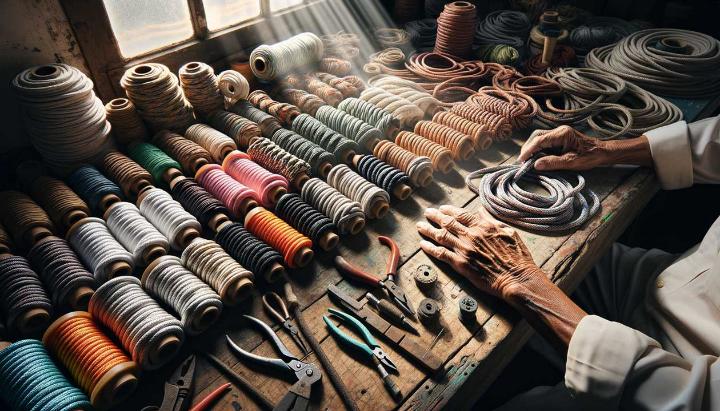Have you ever marvelled at the intricate patterns and surprising strength of a braided rope? From the docks of bustling harbours to the heights of towering skyscrapers, braided ropes play an unsung role in our daily lives. But not all braids are created equal. Today, we're embarking on a journey to explore the fascinating world of braided ropes, with a special focus on the versatile double braid polypropylene rope.
Imagine a rope that floats on water, resists UV damage, and can lift weights that would make your average gym-goer blush. That's the power of polypropylene braid. But it's just one player in a diverse cast of characters. From the soft embrace of cotton braids to the industrial might of polyester, each type of braided rope has its own unique story to tell.
Join us as we unravel the secrets of these remarkable tools, exploring their strengths, applications, and the science behind their construction. Whether you're a seasoned sailor, an industrial professional, or simply curious about the world around you, this deep dive into braided ropes - culminating in the impressive double braid polypropylene rope - promises to be an eye-opening adventure. So, are you ready to get roped in?
Understanding the Basics of Braided Ropes
Have you ever marvelled at the intricate patterns of a braided rope? As someone who's spent years working with various types of ropes, I can tell you that braided ropes are not just visually appealing but also incredibly functional. Let's dive into the world of braided ropes and unravel their secrets together.
Types of Braided Ropes
Braided ropes come in a variety of materials and constructions, each with its own unique properties. The five main types you'll encounter are:
- Cotton braided ropes: Soft and easy to handle, perfect for decorative purposes or gentle applications.
- Polyester braided ropes: Known for their strength and resistance to stretching, ideal for outdoor use.
- Nylon braided ropes: Highly elastic and durable, great for applications requiring shock absorption.
- Leather braided ropes: Stylish and strong, often used in fashion and specialty applications.
- Hemp braided ropes: Natural and biodegradable, popular in eco-friendly settings.
It's worth noting that polypropylene is another material commonly used in braided ropes, known for its lightweight and water-resistant properties.
Braided Rope Construction
Braided ropes are crafted by interweaving multiple strands into a tubular structure, creating a strong and flexible product.
Braided vs. Twisted Ropes: Key Differences
When comparing braided ropes to their twisted counterparts, several key differences emerge:
- Strength: Braided ropes generally offer superior strength-to-weight ratios.
- Flexibility: The braided construction allows for greater flexibility and ease of handling.
- Durability: Braided ropes tend to be more resistant to abrasion and wear.
- Kink resistance: Unlike twisted ropes, braided ropes are less likely to kink or unravel.
In my experience, braided ropes are often the go-to choice for applications requiring a balance of strength, flexibility, and handling ease. For instance, I once used a braided polyester rope for a challenging mountain rescue operation, and its superior grip and flexibility made all the difference in safely extracting the stranded climber.
As we continue to explore the world of braided ropes, you'll discover how their unique properties make them indispensable in various industries, from marine applications to outdoor recreation. Have you ever used a braided rope for a specific task? How did it compare to other rope types you've used? Share your experiences in the comments below!
Exploring the Characteristics of Polypropylene Braid
As we delve deeper into the world of braided ropes, it's time to shine a spotlight on a true workhorse in the industry: polypropylene braid. This synthetic marvel has revolutionised rope-making, offering a unique blend of properties that make it stand out from the crowd. Let's unravel the mysteries of polypropylene braid together, shall we?
Physical Properties of Polypropylene Braid
When you first hold a polypropylene braid rope, you'll immediately notice its lightweight feel. This isn't just a coincidence - it's one of the rope's defining features. With a density of just 0.91 g/cm³, polypropylene braid floats on water, making it a favourite for marine applications. But that's not all:
- UV resistance: Unlike some natural fibres, polypropylene braid laughs in the face of harsh sunlight, maintaining its strength and colour over time.
- Water resistance: Ever seen a soggy rope? Not with polypropylene braid! It doesn't absorb water, keeping its properties intact even in wet conditions.
- Temperature tolerance: While it has a relatively low melting point of about 165°C, polypropylene braid performs admirably in most everyday conditions.

Strength and Durability Features
Now, you might be wondering, "Sure, it's light and water-resistant, but can it handle the tough stuff?" The answer is a resounding yes! Polypropylene braid boasts an impressive strength-to-weight ratio, often outperforming heavier ropes in its class. Here's what makes it a powerhouse:
- High tensile strength: Depending on the diameter, polypropylene braid can handle loads from a few hundred kilograms to several tonnes.
- Abrasion resistance: The braided construction gives this rope excellent resistance to wear and tear, extending its lifespan.
- Chemical resistance: Polypropylene braid stands up well to many chemicals, making it suitable for industrial applications.
Applications and Advantages of Polypropylene Braid
The versatility of polypropylene braid is truly remarkable. From the high seas to your backyard, this rope finds its place in numerous settings:
- Marine use: Its floating ability makes it perfect for water sports, boating, and fishing applications.
- Construction: The rope's strength and durability make it a go-to choice for temporary barriers and safety lines.
- Agriculture: Farmers appreciate its resistance to rot and mildew in outdoor settings.
- Recreation: From camping to playground equipment, polypropylene braid is a safe and reliable option.
I remember using a polypropylene braid rope during a sailing trip in choppy waters. Its buoyancy was a godsend when we needed to recover some gear that had fallen overboard. The rope's visibility and ease of handling made what could have been a disaster into a minor hiccup.
Have you ever used polypropylene braid rope in an unexpected situation? How did it perform compared to other rope types you've used? Share your experiences in the comments below - I'd love to hear your stories!
Strength and Versatility of Double Braid Polypropylene Rope
As we delve deeper into the world of braided ropes, it's time to shine a spotlight on a true marvel: the double braid polypropylene rope. This ingenious design combines the best of both worlds, offering unparalleled strength and versatility that sets it apart from its single-braided counterparts.
Breaking Strength and Load-Bearing Capacity
When it comes to raw power, double braid polypropylene rope is a force to be reckoned with. Let's break down the impressive numbers:
- Impressive breaking strength range: Depending on the diameter, these ropes can withstand loads from 350kg up to a staggering 2990kg.
- Superior to 3-strand ropes: Double braided construction offers significantly higher breaking strength compared to traditional 3-strand ropes of the same diameter.
- Diameter-dependent strength: Larger diameters can achieve breaking strengths of up to 8400 lbs (3810 kg), making them suitable for heavy-duty applications.
It's worth noting that factors like knots and prolonged UV exposure can affect the rope's load-bearing capacity. Always consider these elements when choosing the right rope for your needs.

Advantages in Marine and Industrial Applications
The unique properties of double braid polypropylene rope make it a go-to choice for various demanding environments:
- Buoyancy for marine use: Its ability to float makes it ideal for water sports, boating, and marine rescue operations.
- UV and rot resistance: Unlike natural fibres, this rope maintains its strength and colour even after prolonged exposure to sunlight and moisture.
- Versatility in industrial settings: From construction site safety lines to heavy machinery operations, the rope's strength and durability shine through.
I once witnessed a double braid polypropylene rope in action during a particularly challenging dock mooring operation. The rope's combination of strength and flexibility allowed the crew to secure a large vessel safely, even in choppy waters. It was a testament to the rope's reliability in high-stakes situations.
Have you ever used a double braid polypropylene rope for a specific task? How did it compare to other rope types you've worked with? Share your experiences in the comments below - I'm always eager to hear real-world applications from fellow rope enthusiasts!
Choosing the Right Braided Rope for Your Needs
When it comes to selecting the perfect braided rope, the choices can seem overwhelming. But fear not! As someone who's spent years working with various ropes, I'm here to guide you through the process. Let's dive into the world of braided ropes and discover how to choose the one that's just right for your needs.
Understanding Different Types of Braided Ropes
Before we delve into the selection process, it's crucial to understand the main types of braided ropes available. Each type has its unique properties and best-suited applications:
- Cotton braided ropes: Soft and gentle on the hands, ideal for decorative purposes or indoor use.
- Polyester braided ropes: Known for their strength and UV resistance, perfect for outdoor applications.
- Nylon braided ropes: Highly elastic and durable, great for applications requiring shock absorption.
- Polypropylene braided ropes: Lightweight and water-resistant, excellent for marine environments.
- High Modulus Polyethylene (HMPE) ropes: Incredibly strong and durable, suitable for heavy-duty industrial use.
Remember, the key is to match the rope's properties with your specific needs. For instance, I once used a polyester braided rope for a long-term outdoor project, and its UV resistance proved invaluable in maintaining its strength over time.

Factors to Consider When Selecting Braided Rope
Now that we're familiar with the types, let's explore the crucial factors to consider when selecting your braided rope:
- Intended use: Are you using the rope for marine applications, construction, or recreational purposes? This will significantly influence your choice.
- Required strength: Consider the maximum load your rope needs to handle. Remember, it's always better to choose a rope with a higher strength rating than you think you'll need.
- Environmental conditions: Will your rope be exposed to UV rays, saltwater, or chemicals? Choose a material that can withstand these elements.
- Flexibility and handling: Some applications require ropes that are easy to knot and handle, while others prioritize rigidity.
- Budget: While it's tempting to go for the cheapest option, investing in a high-quality rope can save you money in the long run due to increased durability.
I once made the mistake of using a regular nylon rope for a marine application, only to find it degrading quickly in the saltwater environment. That experience taught me the importance of considering all factors, especially environmental conditions, when selecting a rope.
Tips for Proper Care and Maintenance
Choosing the right rope is only half the battle. To ensure longevity and optimal performance, proper care and maintenance are crucial:
- Regular inspections: Check your rope for signs of wear, fraying, or damage before each use.
- Cleaning: Rinse your rope with fresh water after use, especially if exposed to saltwater or dirt.
- Storage: Store your rope in a cool, dry place away from direct sunlight when not in use.
- Avoid sharp edges: Use protective sleeves or padding when your rope comes into contact with abrasive surfaces.
- Proper coiling: Learn the correct coiling technique to prevent kinks and tangles.
Remember, a well-maintained rope is a safe rope. I've seen ropes last for years with proper care, while neglected ones can become dangerous after just a few uses.
Pro Tip: When in doubt about which rope to choose, consult with a professional or the manufacturer. They can provide valuable insights based on your specific needs and usage scenarios.
Selecting the right braided rope doesn't have to be a daunting task. By considering the type of rope, your specific needs, and following proper care guidelines, you'll be well-equipped to make an informed decision. Remember, the perfect rope is out there – it's just a matter of finding the one that fits your unique requirements like a glove.
Have you had any experiences with selecting or using braided ropes that you'd like to share? What factors do you prioritize when choosing a rope for your projects? Let's continue the conversation in the comments below!
The world of braided ropes is vast and varied, with each type tailored for specific uses. Among them, polypropylene stands out for its lightweight, water-resistant nature, making it a popular choice for marine and outdoor applications. Delve into the fascinating features of polypropylene braid ropes, and understand why double braid polypropylene rope is a game-changer in strength and versatility. Perfect for heavy-duty tasks in marine, industrial, and recreational settings, this rope combines unmatched durability with practical functionality.
Unlock the Potential of Double Braid Polypropylene Rope with iRopes!
Discover the superior qualities of double braid polypropylene rope and see how it can benefit your specific needs. Fill out the form above to get in touch with our experts and find the perfect rope solution for your requirements!